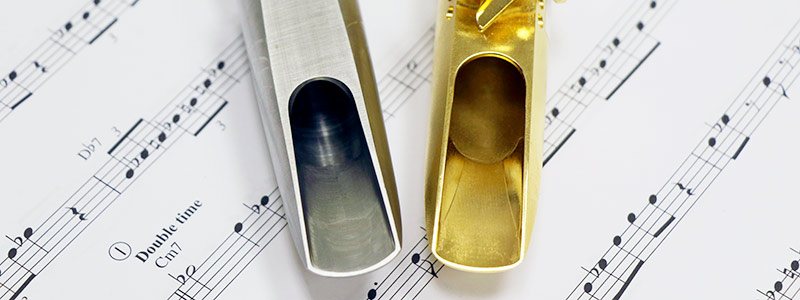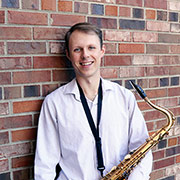
“Knowing how your mouthpiece operates will give you a better idea of what will work best for you.” – Adam Du Vall
One of the most common questions I hear in the Sax Shop is, “Can I look at jazz mouthpieces?” The answer is, of course, “YES!” but is usually followed by a few questions of my own. Most students are interested in getting a “bigger” or “louder” sound, but do not know quite how the mouthpiece achieves it.
Knowing how your mouthpiece operates will give you a better idea of what will work best for you. A jazz mouthpiece will differ dramatically from a regular concert band mouthpiece, mainly by the baffle, tip size, and material.
Baffle is the material that is either built up or carved into the inside tip of a mouthpiece. There are a few different types, but generally speaking, a baffle will speed up your air going into the chamber of the mouthpiece. Speeding up the air will give you a brighter, punchier sound designed to compete with a blasting brass section.
The tip opening of a mouthpiece is the distance between the tip of the reed and the tip of the mouthpiece. Most classical or concert alto mouthpiece tip openings are around .067 inches, where most jazz mouthpieces are between .076 and .090 inches. This gives the reed more room to vibrate, allowing for a brighter sound with more projection. However, a larger tip opening can be much more resistant for players who are used to a smaller one. Try going down a reed strength to bring the flexibility back to the mouthpiece.
Most jazz mouthpieces are made of hard rubber, which is a more musical material than the plastic student mouthpieces. Hard rubber provides a wide variety of tonal options and can provide the user with quite a bit of flexibility. One of the biggest misconceptions of a jazz mouthpiece is that a metal will be louder. This is completely untrue. Metal is a much more machine friendly material and can therefore be made with very thin rails (the two long sides of the mouthpiece that the reed vibrates against). Thinner rails give you a brighter sound, but require a more accurate embouchure. If your face is not set, you will get the inevitable saxophone squeak. Although metal can have a fantastic and exciting sound, it is ill-advised to be your first jazz mouthpiece.
Overall, the best thing you can do when looking for a jazz mouthpiece, is try as many as possible. What works for your friend may not work best for you. Play test multiple mouthpieces with a variety of styles and dynamics, and always check your intonation with a tuner. Contact your Schmitt Music store, or visit The Sax Shop to learn more.
 Adam Du Vall is a classical and jazz saxophone player in the Twin Cities area. Hailing from Green Bay, WI, Adam has been gigging since high school. He graduated from the University of Wisconsin Oshkosh studying Music Recording and Technology. His studies have been with Dr. Marty Robinson, Ms. Sarah Kind, and Dr. Drew Whiting. During his time in the Fox Valley, Adam has played with Big Band Reunion, Water City Jazz Orchestra, the UWO Jazz Ensemble and Combos, New Orleans band Brass Differential, the ska group Pam the Bear, and blues/rock band Paul Robert and the Hall of Famers.
Adam Du Vall is a classical and jazz saxophone player in the Twin Cities area. Hailing from Green Bay, WI, Adam has been gigging since high school. He graduated from the University of Wisconsin Oshkosh studying Music Recording and Technology. His studies have been with Dr. Marty Robinson, Ms. Sarah Kind, and Dr. Drew Whiting. During his time in the Fox Valley, Adam has played with Big Band Reunion, Water City Jazz Orchestra, the UWO Jazz Ensemble and Combos, New Orleans band Brass Differential, the ska group Pam the Bear, and blues/rock band Paul Robert and the Hall of Famers.
After graduation, Adam moved to the Twin Cites area to pursue an internship at RiverRock Studios in Northeast Minneapolis. Currently, Adam works at the studio part time, freelances, performs full time with the R&B/funk band Good Foot Express, and manages the Sax Shop at Schmitt Music in Brooklyn Center.
